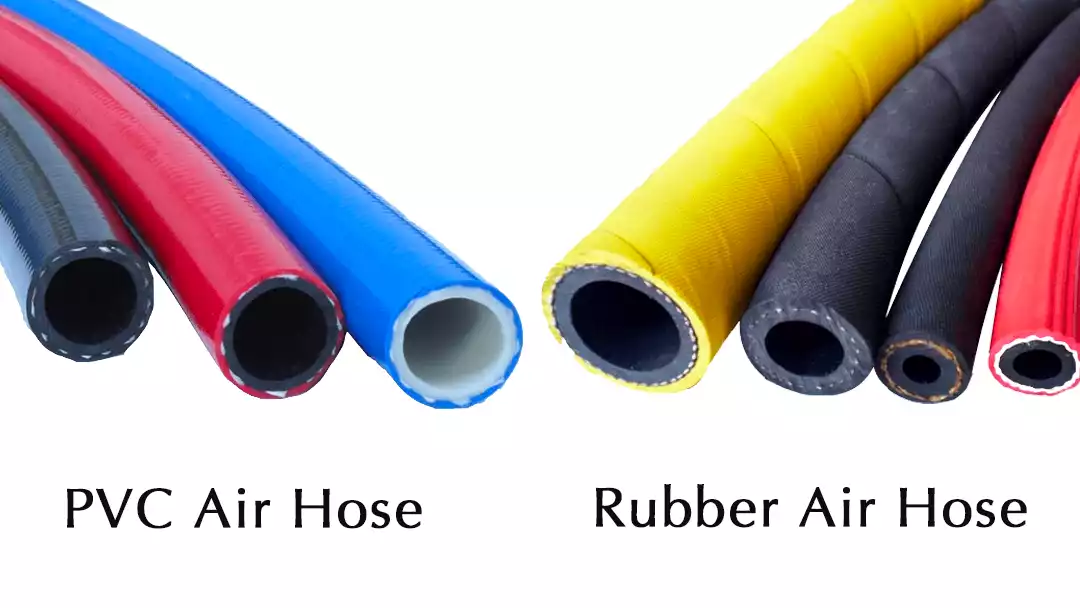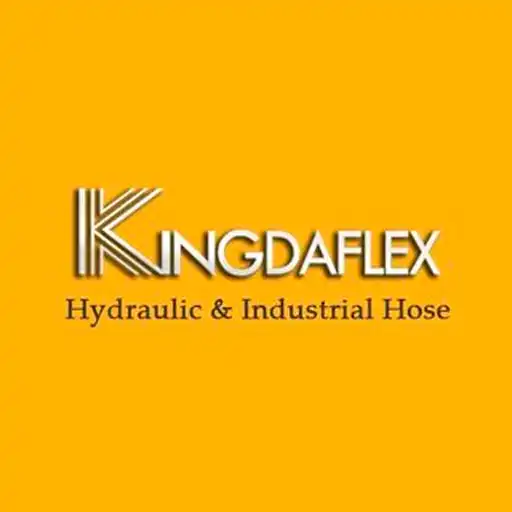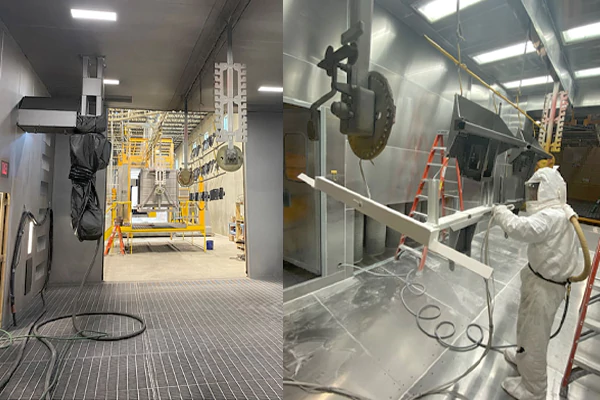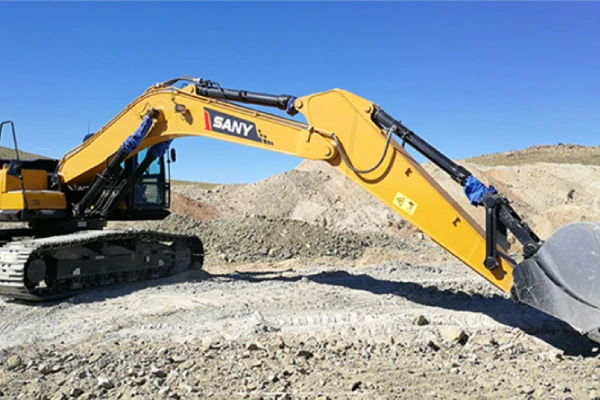Air hoses are essential tools in industries, workshops, and construction sites, ensuring efficient air transfer for pneumatic tools and equipment. Among the popular options, PVC air hoses and rubber air hoses stand out, each offering unique strengths that make them suitable for different working conditions and applications.
Understanding the differences between PVC and rubber air hoses can help users make the right choice based on flexibility, durability, and performance. While PVC air hoses are lightweight and cost-effective, rubber air hoses provide strength and resilience. Comparing these two options ensures you select the best fit for your needs.
What are PVC Air Hoses?
PVC air hoses are lightweight and versatile hoses made from polyvinyl chloride, widely used for transferring compressed air in workshops, garages, and light industrial settings. They are valued for their affordability, flexibility, and resistance to wear, making them a popular choice for general pneumatic applications.
- Lightweight Design – PVC hoses are easy to handle and transport, reducing operator fatigue. Their light construction makes them suitable for applications where frequent movement or repositioning of air tools is required.
- Cost-Effective Option – Compared to rubber hoses, PVC hoses are more affordable, offering a budget-friendly solution without compromising basic performance for everyday use.
- Good Flexibility – These hoses maintain adequate flexibility, especially in moderate temperatures, making them convenient for various pneumatic applications. However, flexibility may reduce in extremely cold conditions.
- Abrasion Resistance – PVC air hoses are resistant to abrasion and surface wear, ensuring durability in environments where hoses may rub against surfaces or equipment.
- Variety of Applications – Ideal for light industrial, automotive, and household tasks, PVC hoses deliver reliable performance for air compressors, pneumatic tools, and general maintenance work.
What are Rubber Air Hoses?
Rubber air hoses are durable, heavy-duty hoses made from synthetic rubber, widely used for demanding pneumatic applications in industrial, automotive, and construction settings. Known for their flexibility and resilience, they provide excellent performance under high pressure, extreme temperatures, and rugged conditions, ensuring reliable and long-lasting air delivery.
- High Durability – Rubber hoses are built to withstand heavy-duty use, offering excellent resistance to wear, cuts, and harsh working environments where reliability is crucial.
- Superior Flexibility – Even in cold weather, rubber hoses remain flexible, preventing kinking or stiffness, and allowing smooth handling in diverse applications.
- Long Service Life – Their strong construction ensures extended hose lifespan, reducing the need for frequent replacements and providing greater value over time.
- Excellent Temperature Resistance – Rubber hoses can endure a wide temperature range, making them suitable for both indoor and outdoor use in varying climates.
- Industrial Applications – Ideal for construction sites, automotive shops, and manufacturing facilities, rubber hoses perform reliably in high-pressure and demanding pneumatic operations.
PVC vs Rubber Air Hose

PVC and rubber air hoses are two of the most common choices for pneumatic systems, each offering unique strengths. Comparing them in terms of flexibility, durability, weight, cost, and applications helps users decide which type suits their work environment and performance requirements best.
Flexibility
PVC air hoses provide adequate flexibility for general use but can stiffen in colder temperatures. They are easy to maneuver in moderate climates, though their bend radius is more limited compared to rubber hoses.
Rubber air hoses remain flexible even in extreme cold or hot conditions. Their elasticity reduces the risk of kinking, making them suitable for demanding applications where consistent movement and bending are required.
Durability
PVC hoses are durable for light to medium-duty tasks but are less resistant to cuts and wear when exposed to rugged environments. They work well in controlled workshop or garage settings.
Rubber hoses are highly durable, built to withstand abrasion, harsh surfaces, and tough working conditions. Their reinforced structure makes them reliable for long-term use in industrial and construction environments.
Weight
PVC air hoses are lightweight, making them easier to carry and manage, especially for users who move air tools frequently. Their reduced weight minimizes operator fatigue during extended use.
Rubber hoses are heavier due to their thick structure, which can be more challenging to handle. However, the added weight contributes to their strength, stability, and long-lasting performance.
Cost
PVC hoses are cost-effective, offering an affordable solution for everyday pneumatic needs. They provide good value for users who don’t require heavy-duty performance.
Rubber hoses are more expensive upfront, but their durability and longer service life justify the investment. They reduce replacement frequency, saving costs in demanding industrial environments over time.
Applications
PVC air hoses are best suited for light industrial, automotive, and household applications, including air compressors, nail guns, and general maintenance.
Rubber air hoses are preferred for heavy-duty construction, automotive repair, and industrial use, where maximum durability, flexibility, and performance are required under pressure and challenging environments.
| Aspect | PVC Air Hose | Rubber Air Hose |
|---|---|---|
| Flexibility | Adequate in moderate climates, stiff in cold | Excellent in all temperatures, resists kinking |
| Durability | Suitable for light to medium-duty use | Highly durable, ideal for rugged environments |
| Weight | Lightweight, easy to handle | Heavier, stronger, more stable |
| Cost | Affordable and budget-friendly | Higher cost but longer lifespan |
| Applications | General, light industrial, and household | Industrial, automotive, and heavy-duty work |
Polyurethane Hose vs Rubber
Polyurethane hoses and rubber hoses are widely used in industries for air, water, and fluid transfer. Choosing the right type depends on flexibility, durability, chemical resistance, and environmental conditions. Understanding their differences ensures optimal performance and long-term reliability in various applications.
Flexibility
Polyurethane hoses are highly flexible, even at low temperatures. Their lightweight design allows easier handling and reduced kinking during operation, making them suitable for applications requiring frequent movement. Rubber hoses, while flexible, are generally heavier and less pliable, especially in cold environments, which can limit mobility and storage options.
Rubber hoses can handle higher pressures without permanent deformation, but they often require more force to bend or maneuver. In contrast, polyurethane maintains its shape and elasticity over long-term use, which reduces strain on equipment and operators in pneumatic or vacuum applications.
Abrasion Resistance
Polyurethane hoses offer superior abrasion resistance, making them ideal for abrasive materials or environments with sharp edges. Their surface resists cuts and wear better than rubber, extending service life in high-friction applications. Rubber hoses are more prone to surface wear when exposed to rough handling or abrasive media.
While rubber hoses can still perform under mild abrasion, their outer layer tends to degrade faster than polyurethane, especially under continuous mechanical stress. Polyurethane hoses maintain consistent wall integrity, reducing leakage risk and maintenance frequency in industrial settings.
Chemical Resistance
Rubber hoses provide moderate chemical resistance, suitable for water, oils, and some chemicals, but they can degrade with strong solvents or acids. Polyurethane hoses exhibit excellent chemical resistance against oils, greases, and some aggressive chemicals, making them more versatile in harsh chemical environments.
This property allows polyurethane hoses to last longer in industrial processes involving petroleum-based fluids or cleaning agents. Rubber hoses may require frequent replacement if exposed to reactive chemicals, leading to downtime and additional costs.
Temperature Range
Rubber hoses generally tolerate higher temperatures than polyurethane hoses, making them suitable for hot water or steam applications. Polyurethane hoses perform better in cold conditions but may soften at elevated temperatures, limiting their use in high-heat environments.
Rubber’s thermal stability ensures reliability in automotive and industrial systems exposed to engine heat. Polyurethane excels in environments where flexibility at low temperatures is crucial, such as pneumatic lines in refrigerated areas.
Weight and Handling
Polyurethane hoses are lighter than rubber hoses, improving ease of installation and reducing operator fatigue. Their lightweight nature makes them ideal for handheld tools and mobile equipment. Rubber hoses are heavier and bulkier, which can make handling, coiling, and transportation more cumbersome.
Despite the weight advantage of polyurethane, rubber hoses provide stability and resistance to crushing under heavy equipment. The choice depends on whether ease of handling or structural robustness is a priority.
Nylon vs Polyurethane Air Hose
Nylon hoses and polyurethane air hoses are common in pneumatic systems, workshops, and industrial applications. Each material has unique properties affecting flexibility, abrasion resistance, chemical tolerance, and overall durability. Choosing the right hose ensures efficient air delivery and reduces maintenance issues.
Flexibility
Polyurethane hoses are extremely flexible, making them ideal for applications with frequent bending or movement. Their elasticity allows them to return to shape quickly, preventing kinks and tangling. Nylon hoses are also flexible but generally stiffer than polyurethane, especially in low temperatures, which can make handling less convenient.
Nylon hoses maintain moderate flexibility under normal operating conditions but may crack or become brittle if exposed to prolonged low temperatures. Polyurethane hoses, being lighter and more pliable, reduce strain on operators during extended use in workshops or production lines.
Abrasion Resistance
Polyurethane hoses exhibit excellent abrasion resistance, which protects them from surface wear, cuts, and friction during frequent handling. Nylon hoses are durable but less resistant to abrasion, making them prone to scuffs or damage in high-contact areas or rough surfaces.
In industrial environments with moving tools or sharp edges, polyurethane hoses maintain performance over time. Nylon hoses may require additional protective sleeves or careful routing to avoid premature wear, increasing maintenance complexity.
Chemical Resistance
Polyurethane hoses offer good chemical resistance to oils, greases, and mild chemicals, though extremely strong solvents may still cause degradation. Nylon hoses resist certain oils and fuels but can be more vulnerable to hydrolysis when exposed to moisture or water-based chemicals over time.
This difference makes polyurethane hoses better suited for environments with occasional chemical exposure, while nylon hoses require careful monitoring to prevent chemical-related damage and potential air leakage.
Temperature Range
Nylon hoses perform well in higher-temperature applications compared to polyurethane hoses, tolerating heat from compressors and machinery. Polyurethane hoses excel in cold environments, maintaining flexibility, but may soften or degrade under prolonged high heat.
Rubberized nylon blends enhance thermal stability, but pure nylon still requires caution in extreme temperatures. Polyurethane hoses are preferred in refrigerated or low-temperature operations where flexibility is crucial.
Weight and Handling
Polyurethane hoses are lightweight and easy to handle, ideal for handheld tools and mobile systems. Nylon hoses are slightly heavier and stiffer, making coiling and maneuvering less convenient, especially over long distances or in tight spaces.
The lightweight nature of polyurethane reduces operator fatigue and installation time. Nylon hoses, although strong, may demand more effort for setup or adjustments in dynamic work environments.
| Aspect | Polyurethane Hose | Nylon Hose |
|---|---|---|
| Flexibility | Highly flexible, kink-resistant | Flexible but stiffer, less pliable |
| Abrasion Resistance | Excellent, resists cuts/wear | Moderate, scuffs easier |
| Chemical Resistance | Good, resistant to oils/grease | Moderate, vulnerable to hydrolysis |
| Temperature Range | Cold-tolerant, softens in heat | High-temp tolerance, less cold-friendly |
| Weight & Handling | Lightweight, easy to maneuver | Slightly heavier, less easy to handle |
How to PVC and Rubber Air Hoses?
Using PVC and rubber air hoses properly ensures safety, extends hose life, and maintains efficient airflow in pneumatic systems. Each material has unique handling, storage, and maintenance requirements. Understanding these best practices prevents leaks, kinks, and damage, keeping air tools and equipment running smoothly.
Inspect Before Use
- Always check hoses for cracks, leaks, or wear before connecting to air compressors.
Inspecting PVC and rubber hoses before each use prevents unexpected failures during operation. Look for surface abrasions, cuts, or stiffness, which can indicate aging or potential rupture. Identifying damage early ensures worker safety and system reliability. - Ensure fittings and couplings are secure and undamaged.
Loose or damaged fittings can cause air leaks, reducing tool efficiency and increasing risk of accidents. Tight connections prevent hose blowouts and maintain consistent pressure. Both PVC and rubber hoses rely on proper attachment to deliver optimal airflow safely.
Proper Storage
- Coil hoses neatly after use, avoiding sharp bends or twists.
Correctly storing hoses prevents kinking and extends lifespan. PVC hoses are more prone to cracking if bent sharply, while rubber hoses can retain kinks if coiled improperly. Neat storage also saves workspace and prevents tripping hazards. - Keep hoses away from direct sunlight or extreme heat.
Excessive heat can degrade both PVC and rubber hoses, reducing flexibility and strength. UV exposure weakens PVC, while heat may soften rubber, increasing wear. Proper storage in shaded or indoor areas maintains hose integrity for long-term use.
Pressure Management
- Use hoses within their recommended pressure ratings.
Exceeding pressure limits can cause hose bursts and damage pneumatic tools. PVC hoses generally handle lower pressures than rubber, so always check the manufacturer’s specifications. Maintaining proper pressure ensures safe, efficient air delivery for industrial or workshop tasks. - Avoid sudden pressure spikes or repeated hammering of air.
Rapid pressure changes stress hose walls, leading to fatigue or rupture over time. Rubber hoses tolerate sudden spikes better than PVC, but all hoses benefit from gradual pressurization and regulated airflow for durability and safety.
Cleaning and Maintenance
- Wipe down hoses regularly to remove dust, oil, or debris.
Keeping hoses clean prevents abrasion and chemical damage, particularly for rubber hoses exposed to oils. PVC hoses can accumulate grime that stiffens the material over time. Routine cleaning enhances hose flexibility and prolongs lifespan. - Check for internal blockages or moisture accumulation.
Airborne debris or moisture can clog hoses, reducing efficiency and damaging connected tools. Rubber hoses may absorb moisture, so periodic draining or inspection ensures consistent performance. PVC hoses resist moisture but still require internal checks to prevent pressure loss.
Conclusion
PVC air hoses and rubber air hoses both have their advantages, and the best choice depends on your work environment. PVC hoses are lightweight, affordable, and ideal for lighter applications, while rubber hoses are more durable, flexible, and reliable for demanding industrial conditions.
Selecting the right hose ensures maximum efficiency, safety, and longevity for your pneumatic tools and systems. Evaluating your budget, operating conditions, and hose performance will help determine whether a PVC or rubber air hose is the right option for your application.
At Kingdaflex, we provide wholesale PVC hoses and rubber hoses designed to meet various industrial and commercial needs. Whether you require lightweight PVC hoses for cost-effective use or heavy-duty rubber hoses for long-lasting performance, our products deliver consistent quality. Contact Kingdaflex today to source reliable hoses at competitive wholesale pricing.




